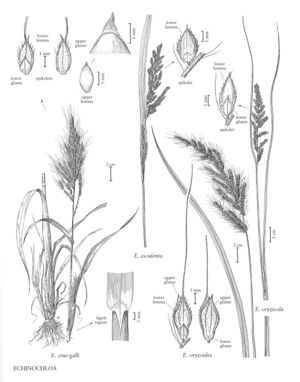Echinochloa crus-galli
Plants annual. Culms 30-200 cm, spreading, decumbent or stiffly erect; nodes usually glabrous or the lower nodes puberulent. Sheaths glabrous; ligules absent, ligule region sometimes pubescent; blades to 65 cm long, 5-30 mm wide, usually glabrous, occasionally sparsely hirsute. Panicles 5-25 cm, with few-many papillose-based hairs at or below the nodes of the primary axes, hairs sometimes longer than the spikelets; primary branches 1.5-10 cm, erect to spreading, longer branches with short, inconspicuous secondary branches, axes scabrous, sometimes also sparsely hispid, hairs to 5 mm, papillose-based. Spikelets 2.5-4 mm long, 1.1-2.3 mm wide, disarticulating at maturity. Upper glumes about as long as the spikelets; lower florets sterile; lower lemmas unawned to awned, sometimes varying within a branch, awns to 50 mm; lower paleas subequal to the lemmas; upper lemmas broadly ovate to elliptical, coriaceous portion rounded distally, passing abruptly into an early-withering, acuminate, membranous tip that is further demarcated from the coriaceous portion by a line of minute hairs (use 25x magnification); anthers 0.5-1 mm. Caryopses 1.3-2.2 mm long, 1-1.8 mm wide, ovoid or oblong, brownish; embryos 59-86% as long as the caryopses. 2n = 54.
Discussion
Echinochloa crus-galli is a Eurasian species that is now widely established in the Flora region, where it grows in moist, disturbed sites, including rice fields. Some North American taxonomists have interpreted E. crus-galli much more widely; others treat it as here, but recognize several infraspecific taxa based on such characters as trichome length and abundance, and awn length. There are several ecological and physiological ecotypes within the species, but the correlation between these and the species' morphological variation has not been established, so no infraspecific taxa are recognized here.
Selected References
None.
